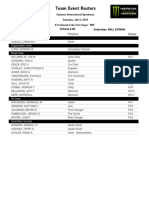Measure What Matters PDF
Measure What Matters PDF
Uploaded by
Sameer SamouaCopyright:
Available Formats
Measure What Matters PDF
Measure What Matters PDF
Uploaded by
Sameer SamouaOriginal Title
Copyright
Available Formats
Share this document
Did you find this document useful?
Is this content inappropriate?
Copyright:
Available Formats
Measure What Matters PDF
Measure What Matters PDF
Uploaded by
Sameer SamouaCopyright:
Available Formats
Insights from Measure What Matters by John Doerr
“As much as I hate process, good ideas with great execution are how you make magic. And that’s where OKRs come in.” – Larry Page,
Google co‐founder
The Objective: WHAT you want to achieve.
The Key Results: HOW you’re going to achieve your objective; 3‐5 measurements that indicate you’re moving closer to your objective.
Common key results include revenue, growth, active users, customer satisfaction scores, etc.
3 Essentials for Setting OKRs
Audacious Objective
Set an audacious objective by being idealistic, not realistic. Ask yourself:
If I were freed from constraints, what change would I want to make in the world?
If I had the unique opportunity to be the best in the world at one thing, what would that be?
After discovering a goal that inspires you, scale it back until it’s one step short of being impossible. Your
objective must be significant and inspiring, but believable.
When Bill and Melinda Gates started 'The Gates Foundation,' they set an audacious objective of eradicating malaria by 2015. However, they
realized it was an impossible goal that demotivated the team, so they adjusted their objective to eradicate malaria by 2040. The new
objective was still big, but now it was believable. This audacious objective inspired the team to grow to meet the challenge.
"When you try to do something BIG, you never entirely fail" ‐ Larry Page
Quality & Quantity Key Results
“Objectives are the stuff of inspiration and far horizons. Key results are more earthbound and metric‐driven.” ‐ John Doerr
Example Objective (from the book): Win the Indy 500
Weak Key Results: Average Key Results: Strong Key Results:
Increase lap speed Increase average lap speed by 2% Increase average lap speed by 2% (quantity result)
Reduce pit stop time Reduce average pit stop time by 1 Reduce average pit stop time by 1 second
second (quantity result)
Reduce pit stop errors by 50% (quality result)
Practice pit stops 1 hour a day (quality and quantity
result)
A strong set of key results are specific and measurable quality and quantity targets. When you have quality and quantity key results, you
reduce costly errors and re‐work.
Key results are like gauges on the dashboard of your vehicle. You want to increase average speed while keeping your RPM and engine
temperature low so that you can get to your destination as efficiently as possible.
Color Coding Check‐ins
Regular color‐coding check‐ins will keep you accountable for setting challenging key result targets and making progress on those key
results.
Each week, month or quarter (you choose the time frame based on your key results), look at your key results and label each result green,
yellow or red.
Green means you are 70%‐100% on target, and you should continue with your current strategy.
Yellow means you are 30%‐70% on target, and you need to develop a recovery plan and adjust your strategy.
Red means you are 0%‐30% on target, and you need to develop a recovery plan or replace that key result.
“There’s no need to hold stubbornly to an outdated projection—strike it from your list and move on. Our goals are servants to our
purpose, not the other way around.” ‐ John Doerr
WARNING: If you're approaching 100% on all your key results, you've failed. Aim for a mix of yellow and green key results, with an average
key result score of 70% on target. "The biggest risk of all is not taking one." ‐ Mellody Hobson
“OKRs allowed us to be ambitious and disciplined at the same time.” ‐ Bill Gates
www.ProductivityGame.com
You might also like
- Programming Questions For FCADocument12 pagesProgramming Questions For FCAkumar71% (31)
- Measure What Matters PDFDocument1 pageMeasure What Matters PDFTime100% (1)
- Technical English 2 A Libro PDFDocument70 pagesTechnical English 2 A Libro PDFFRANCISCO JOSÉ ARES SANCHEZ67% (3)
- The 12 Week Year Getting Started Course (Lesson 3)Document8 pagesThe 12 Week Year Getting Started Course (Lesson 3)50interviews100% (3)
- Cloverleaf Community - PlanDocument70 pagesCloverleaf Community - PlanJackNo ratings yet
- Measure What Matters PDFDocument1 pageMeasure What Matters PDFTimeNo ratings yet
- Measure What Matters PDFDocument1 pageMeasure What Matters PDFddmNo ratings yet
- One Page Plan ExampleDocument7 pagesOne Page Plan ExampleBhinitha Chandrasagaran100% (2)
- Natural Blush Cosmetics: Setting A Science-Based Carbon Reduction TargetDocument6 pagesNatural Blush Cosmetics: Setting A Science-Based Carbon Reduction TargetdanielNo ratings yet
- The 4 Disciplines of Execution PDFDocument1 pageThe 4 Disciplines of Execution PDFSameer SamouaNo ratings yet
- GRAND-AM 2011 Sporting Regulations PDFDocument90 pagesGRAND-AM 2011 Sporting Regulations PDFbarabbaladroNo ratings yet
- Mak Corp Group C ManualDocument18 pagesMak Corp Group C ManualPablo D. FloresNo ratings yet
- CRISILDocument11 pagesCRISILrajputarvi50% (2)
- Summary and Analysis of Never Split the Difference:: Negotiating As If Your Life Depended On ItFrom EverandSummary and Analysis of Never Split the Difference:: Negotiating As If Your Life Depended On ItNo ratings yet
- Forbes - February 6 2015 inDocument96 pagesForbes - February 6 2015 inBeatrix KovácsNo ratings yet
- OYO Company Profile PDFDocument23 pagesOYO Company Profile PDFerry ekaNo ratings yet
- How Foreigners Can Set Up A Business in Saudi ArabiaDocument9 pagesHow Foreigners Can Set Up A Business in Saudi ArabiaSaleem KPNo ratings yet
- Chris Hooper - Who Broke My CashflowDocument43 pagesChris Hooper - Who Broke My CashflowChris Hooper100% (1)
- Exim BankDocument16 pagesExim BankRavi PatilNo ratings yet
- LayoffDocument30 pagesLayoffsonuka83% (6)
- Credit Risk Analyst Interview Questions and Answers 1904Document13 pagesCredit Risk Analyst Interview Questions and Answers 1904MD ABDULLAH AL BAQUINo ratings yet
- What Are Your Biggest Problems and How Can I Help You Solve Them?Document3 pagesWhat Are Your Biggest Problems and How Can I Help You Solve Them?robert_geller_40% (1)
- Ch-1 PPT Principles of MKTDocument22 pagesCh-1 PPT Principles of MKTBamlak WenduNo ratings yet
- Raakh by Mustansar Hussain TararDocument294 pagesRaakh by Mustansar Hussain TararBushra MehdiNo ratings yet
- How I Braved Anu Aunty and Co Founded A MillionDocument4 pagesHow I Braved Anu Aunty and Co Founded A MillionAbhishek HsNo ratings yet
- SWOT Analysis NestléDocument4 pagesSWOT Analysis NestléS Sohaib HGNo ratings yet
- Treasury Management - Final 1Document19 pagesTreasury Management - Final 1bigbazaar100% (1)
- Role of Development Banking in NigeriaDocument82 pagesRole of Development Banking in NigeriaGodwin ArigbonuNo ratings yet
- Measure What Matters PDFDocument1 pageMeasure What Matters PDFviadjbvdNo ratings yet
- Measure What Matters PDFDocument1 pageMeasure What Matters PDFRatna YuningsihNo ratings yet
- Measure What Matters - Complete PDF SummaryDocument8 pagesMeasure What Matters - Complete PDF SummaryExcipio LuxNo ratings yet
- PRODUCT OKRsDocument16 pagesPRODUCT OKRsJemimah AlobaNo ratings yet
- Qualpro MVT Process: Natso Show 2012Document9 pagesQualpro MVT Process: Natso Show 2012NATSOIncNo ratings yet
- E-Book The Ultimate OKR Starter GuideDocument26 pagesE-Book The Ultimate OKR Starter GuideAchinGupta100% (1)
- Case Zando Pharmaceutical (Pertemuan 14)Document6 pagesCase Zando Pharmaceutical (Pertemuan 14)naufalmuhammadNo ratings yet
- Reading Material - Day 3 - Strategy For SuccessDocument25 pagesReading Material - Day 3 - Strategy For SuccesssouravNo ratings yet
- Quality With Statistics-2Document58 pagesQuality With Statistics-2NAITIKNo ratings yet
- OKR & AgileDocument112 pagesOKR & AgileMauricio LopezNo ratings yet
- Soal Kasus Zendo AmlDocument7 pagesSoal Kasus Zendo AmlHERISTIKA NIRWANINo ratings yet
- Hacking Adwords: (One Weird Trick That Could Save You Thousands)Document9 pagesHacking Adwords: (One Weird Trick That Could Save You Thousands)aNo ratings yet
- Hacking Adwords: (One Weird Trick That Could Save You Thousands)Document9 pagesHacking Adwords: (One Weird Trick That Could Save You Thousands)RichardNo ratings yet
- Hacking Adwords: (One Weird Trick That Could Save You Thousands)Document9 pagesHacking Adwords: (One Weird Trick That Could Save You Thousands)aphraxNo ratings yet
- Hacking Adwords: (One Weird Trick That Could Save You Thousands)Document9 pagesHacking Adwords: (One Weird Trick That Could Save You Thousands)RichardNo ratings yet
- Key ResultsDocument19 pagesKey ResultsdesignbyheyalexmNo ratings yet
- Green Productivity PDFDocument341 pagesGreen Productivity PDFSiddharth PalNo ratings yet
- OKR Spreadsheet by PerdooDocument7 pagesOKR Spreadsheet by PerdoobondionjiNo ratings yet
- How To Write Great Performance MeasuresDocument33 pagesHow To Write Great Performance MeasuresArturoNo ratings yet
- OKRs in Product Management 1721797600Document7 pagesOKRs in Product Management 1721797600Ashutosh kumarNo ratings yet
- Understanding 6 SigmaDocument101 pagesUnderstanding 6 SigmalarryrubNo ratings yet
- Stamatiadis Informa Jan 2013Document36 pagesStamatiadis Informa Jan 2013Dimitri StamatiadisNo ratings yet
- Hacking Google Ads: One Weird Trick That Could Save You ThousandsDocument7 pagesHacking Google Ads: One Weird Trick That Could Save You ThousandsTorikul FauziNo ratings yet
- Group6 GoogleDocument16 pagesGroup6 GoogleShivakshi SinghalNo ratings yet
- Rajkumar Selvaraj On LinkedIn IMPROVING THE SYSTEDocument14 pagesRajkumar Selvaraj On LinkedIn IMPROVING THE SYSTEjamessbaand.786No ratings yet
- SMART Goals and OKRsDocument9 pagesSMART Goals and OKRsLevanaNo ratings yet
- Subast CarDocument20 pagesSubast CarVictor Garcia LlobregatNo ratings yet
- Human Resource Management in Textile Industry, It's Impact On ProfitabilityDocument5 pagesHuman Resource Management in Textile Industry, It's Impact On ProfitabilityShaheeda janubhai100% (1)
- Key ResultsDocument19 pagesKey ResultsdesignbyheyalexmNo ratings yet
- Cheat Notes - OKR FundamentalsDocument3 pagesCheat Notes - OKR FundamentalsJose AdityaNo ratings yet
- A DFT Study of Transition Metal (Fe, Co, Ni, Cu, Ag, Au, RH, PD, PT and Ir) Embedded Momolayer MoS2 For Gas AdsorptionDocument3 pagesA DFT Study of Transition Metal (Fe, Co, Ni, Cu, Ag, Au, RH, PD, PT and Ir) Embedded Momolayer MoS2 For Gas AdsorptionManish GurjarNo ratings yet
- Vision: Principles and Values That The Leader Will Follow in Carrying Out The Activities of The OrganizationDocument2 pagesVision: Principles and Values That The Leader Will Follow in Carrying Out The Activities of The OrganizationNiloy NiloyNo ratings yet
- Chap 1 ProductivityDocument21 pagesChap 1 ProductivityMojery MohauNo ratings yet
- UnivDocument26 pagesUnivlmcNo ratings yet
- Part - A: 1) ObjectsDocument27 pagesPart - A: 1) ObjectsSameer SamouaNo ratings yet
- Cyber Security-TerminologyDocument13 pagesCyber Security-TerminologySameer SamouaNo ratings yet
- Back To The SenderDocument6 pagesBack To The SenderSameer SamouaNo ratings yet
- Grit PDFDocument1 pageGrit PDFSameer SamouaNo ratings yet
- Sa-1 Grade 4 - Math QPDocument9 pagesSa-1 Grade 4 - Math QPSameer SamouaNo ratings yet
- Ezolvin Syrup Patient Information Leaflet PDFDocument1 pageEzolvin Syrup Patient Information Leaflet PDFSameer SamouaNo ratings yet
- Insights From The 4-Hour Workweek by Tim Ferriss: Nathan Lozeron, @nlozeronDocument1 pageInsights From The 4-Hour Workweek by Tim Ferriss: Nathan Lozeron, @nlozeronSameer SamouaNo ratings yet
- Cybersecurity Training: Safeguarding Industrial Automation and Control SystemsDocument12 pagesCybersecurity Training: Safeguarding Industrial Automation and Control SystemsSameer SamouaNo ratings yet
- 5 - Effectiveness of Vitamin D in Prevention of DHF & DssDocument3 pages5 - Effectiveness of Vitamin D in Prevention of DHF & DssSameer SamouaNo ratings yet
- How To Enable Instaon Option in DVRDocument3 pagesHow To Enable Instaon Option in DVRSameer SamouaNo ratings yet
- Traditional Islamic Medicine and Remedies Medicines of The ProphetDocument4 pagesTraditional Islamic Medicine and Remedies Medicines of The ProphetSameer SamouaNo ratings yet
- Quercetin A Promising Treatment For The Common Cold 2329 8731.1000111Document3 pagesQuercetin A Promising Treatment For The Common Cold 2329 8731.1000111Sameer SamouaNo ratings yet
- Incorporating Al-Ghazali'S Theory in Understanding Allah'S Name Al-Hakim Towards Character Development Among YouthDocument7 pagesIncorporating Al-Ghazali'S Theory in Understanding Allah'S Name Al-Hakim Towards Character Development Among YouthSameer SamouaNo ratings yet
- Media Bulletin 01 10 2020 PDFDocument44 pagesMedia Bulletin 01 10 2020 PDFSameer SamouaNo ratings yet
- ABC ChecklistDocument1 pageABC ChecklistSameer Samoua100% (1)
- 99 Names of Allah (Al Asma Ul Husna) - With Meaning and Explanation PDFDocument43 pages99 Names of Allah (Al Asma Ul Husna) - With Meaning and Explanation PDFSameer SamouaNo ratings yet
- John Doe Mpa SampleDocument56 pagesJohn Doe Mpa SampleSameer SamouaNo ratings yet
- 99 Names of Allah (Al Asma Ul Husna) - With Meaning and Explanation PDFDocument43 pages99 Names of Allah (Al Asma Ul Husna) - With Meaning and Explanation PDFSameer SamouaNo ratings yet
- F1Document29 pagesF1yoyotoyoNo ratings yet
- TRC General RulebookDocument10 pagesTRC General RulebookGino PanevinoNo ratings yet
- Advanced Racing GuideDocument45 pagesAdvanced Racing Guidewill1223917832No ratings yet
- Cement ReportDocument86 pagesCement ReportSohaibNo ratings yet
- B-82874SP - 08 ARC Mate 120ic M-20iA MECHANICAL UNIT Operator PDFDocument225 pagesB-82874SP - 08 ARC Mate 120ic M-20iA MECHANICAL UNIT Operator PDFScribdTranslationsNo ratings yet
- Mini4WD Stock Race Rules and Regulations August 2016 (Complete Set)Document11 pagesMini4WD Stock Race Rules and Regulations August 2016 (Complete Set)Ian Eldrick Dela CruzNo ratings yet
- Ed Formula D RulebookDocument5 pagesEd Formula D RulebookAngel TellezNo ratings yet
- 2023 NASCAR Cup Series New Hampshire Crew RostersDocument36 pages2023 NASCAR Cup Series New Hampshire Crew RostersCj goodNo ratings yet
- Rule Book - The Hansraj Case Challenge 3.0Document3 pagesRule Book - The Hansraj Case Challenge 3.0Rajat NNo ratings yet
- Handbok Radical CarsDocument60 pagesHandbok Radical CarsHan TanNo ratings yet
- F24 Technical and Sporting Regulations 2022 V1.0Document17 pagesF24 Technical and Sporting Regulations 2022 V1.0Marcos AbilleiraNo ratings yet
- 2019 Makabayan Endurance Race Series Rules and RegulationsDocument19 pages2019 Makabayan Endurance Race Series Rules and Regulationslantraluvr3031No ratings yet
- SMED Training Material PDFDocument35 pagesSMED Training Material PDFEr Jagadish MandalNo ratings yet
- Racing Simulation of A Formula 1 Vehicle With Kinetic Energy Recovery SystemDocument15 pagesRacing Simulation of A Formula 1 Vehicle With Kinetic Energy Recovery SystemRodrigo Bob100% (1)
- Team Event Rosters: Starcom Racing Vehicle # 00Document40 pagesTeam Event Rosters: Starcom Racing Vehicle # 00TobyChristie506No ratings yet
- 361050Document38 pages361050TobyChristie506No ratings yet
- Assignment 1: Due Date: January 25, 2022, 11:55pm ISTDocument5 pagesAssignment 1: Due Date: January 25, 2022, 11:55pm ISTvivekNo ratings yet
- Michigan International Speedway 2019: 1:30 PM 3:30 PM Mencs Hot Pass in EffectDocument2 pagesMichigan International Speedway 2019: 1:30 PM 3:30 PM Mencs Hot Pass in EffectTobyChristie506No ratings yet
- Manual PDFDocument13 pagesManual PDFJnyanendra Kumar PradhanNo ratings yet
- Data Output From F1 22 v14Document28 pagesData Output From F1 22 v14Gabriele CanoNo ratings yet
- ChangelogDocument56 pagesChangelogTancu SebastianNo ratings yet
- 6.2 - Common Hooks in React: Useeffect, Usecallback, Usememo, Custom Hooks Prop DrillingDocument33 pages6.2 - Common Hooks in React: Useeffect, Usecallback, Usememo, Custom Hooks Prop DrillingAdesh Kumar chaturvediNo ratings yet
- ACC DRIVE User Manual v0.1Document18 pagesACC DRIVE User Manual v0.1Laurentiu GirleanuNo ratings yet
- Formula 1 Sporting Regulations.Document112 pagesFormula 1 Sporting Regulations.igormatheus.orusNo ratings yet
- Fórmula D - Regras AvançadasDocument16 pagesFórmula D - Regras AvançadasEverson JacintoNo ratings yet
- Season Planner - 51: MoneyDocument206 pagesSeason Planner - 51: MoneyYoYo RASNANo ratings yet











































































































